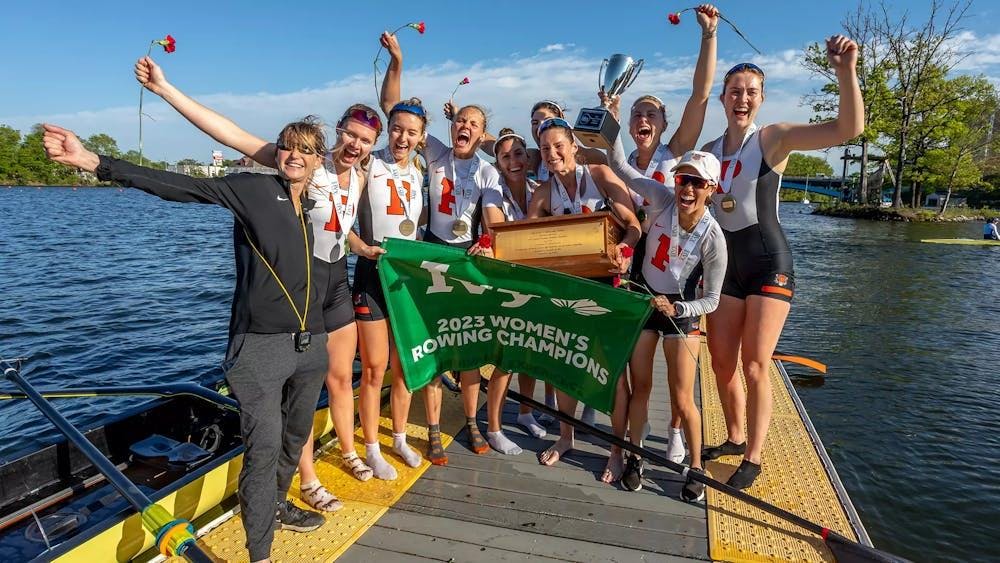The Ivy League has a long and storied presence at the Olympic Games. In the first modern Olympic Games in 1896, 241 men from 14 nations competed in Athens, Greece. Team USA was made of 12 men, all from Columbia, Harvard, and Princeton.
Since then, the League has dominated rowing, represented dozens of countries across the world, and Harvard has managed to make an appearance in every game.
The 109 athletes the Ivy League sent to compete in the 2024 Olympic Games in Paris mark the most the conference has ever sent. Since the 2016 Summer Games in Rio, Princeton has sent the most or second-most athletes to each Games from the conference, and overall ranks fourth in Ivy League Olympians.
The Daily Princetonian analyzed Ivy League Olympic rosters of current and former students who participated in the modern Games. Paralympians and alternates are included in the analysis, but coaches and support staff are not.
The first Ivy League Olympians competed in “Athletics” — another term for what are now widely known as “Track & Field” events in the United States. While Harvard advised competitors to travel under the Boston Athletic Association, the first Team Princeton all traveled under the Orange and Black banner.
By the fourth modern Olympics — the 1908 games in London — all Ivy League institutions had sent at least one representative to a Game, with Dartmouth being the last to do so. The 2024 Olympic Games mark the eleventh time where all Ivies are represented, the previous occurrence was the 2012 Games in London.
While Harvard — followed by Dartmouth — has sent the most overall athletes to the Olympics, Dartmouth sent only seven athletes to Paris this summer, the third lowest in the conference. Princeton’s 25 athletes are the second highest in the conference, two fewer than Harvard’s 26 Olympians and one Paralympian.
Penn has sent athletes to the second fewest Games after Columbia, and attended the same number as Brown, but has sent over double the number of athletes the Bears have sent in their history. The 1970s and 80s gave the Quakers a boost — in each of the four summer Games between 1972 and 1984, Penn sent more athletes than any other Ivy, except in 1972 when Penn and Harvard each sent 12.
Brown has sent the fewest Olympians to Paris with four athletes. Princeton’s large number of athletes sent in the past few years vaulted the Tigers above Penn’s all-time athletes.

Overall, the largest percentage of Ivy League Olympians have competed in rowing — 28 percent of all time conference Olympians. In Paris, rowers comprise 38 percent of the conference representation — 17 of whom hail from Yale and nine from Princeton. Three Tiger rowers have secured Olympic medals: Nick Mead ’17 and Hannah Scott ’21 took home gold for Team USA and Great Britain, respectively, and Tom George ’18 won silver for Team GB.
Team Princeton won another gold in fencing — the second most represented sport by the Ivy League in Paris, representing 19 percent of conference athletes — with eight from Harvard and seven from Princeton. Maia Weintraub ’26 took home gold in foil securing the first USA gold in team fencing history. Three out of the four women’s fencers trained in the Ivy League.
Seventeen sports have at least one Ivy League competitor in Paris, alongside three Paralympic events.
Since 2016, 55 percent of Ivy League athletes have competed for Team USA. Each Games, Canada has been the next most popular nation for Ivy Leaguers to compete for, with seven percent of the conference’s Paris athletes sporting red and white Lululemon suits on the River Seine. Twenty-three countries have Ivy League representation in Paris, with teams Harvard and Yale each on the rosters of 10 nations and Princeton on nine. Cornell’s five Olympians in Paris are all on Team USA, alongside all four Paralympians from Columbia, Dartmouth, Harvard, and Yale.
The Olympic Games continue through Aug. 11 followed by the Paralympic Games.
Andrew Bosworth is a head Data editor and staff Sports writer for the ‘Prince.’
Please send any corrections to corrections[at]dailyprincetonian.com.








